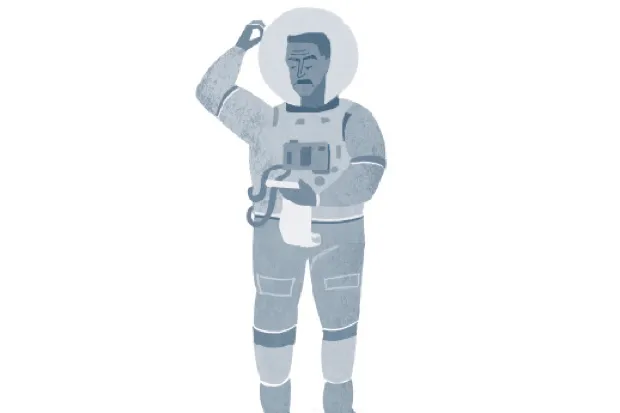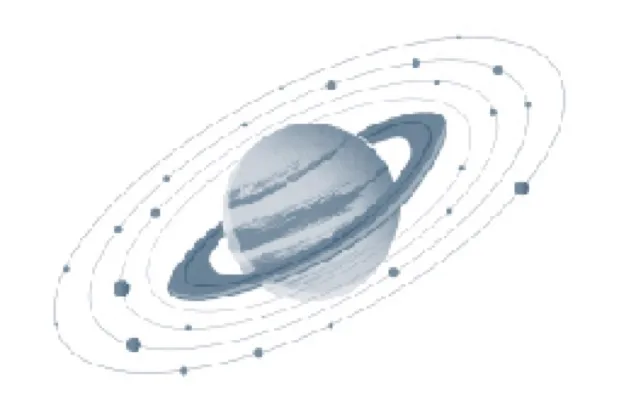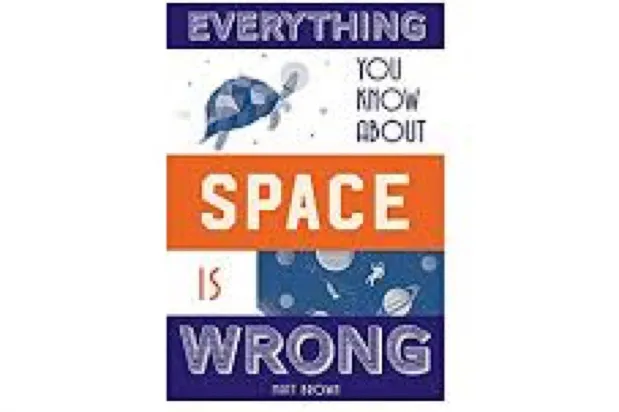In his new book, Everything you know about space is wrong, Matt Brown tackles some of the myths and misconceptions about outer space, and human space explanation. Here are a few space “facts” that you’ve happily believed all these years:
1
Your body would explode in the vacuum of space

What would it feel like to float out of an airlock without a spacesuit? Would you explode? Would your eyes pop out? Would you die instantly? The experience would be deeply traumatic certainly, but not immediately fatal.
Your body would face several challenges all at the same time. Lack of oxygen, low temperature and high radiation are all unpleasant but won’t get you right away. The biggest challenge is the lack of pressure. Normally, our bodies are in balance with the environment. In space, there is no pressure. It’s a vacuum. The outside of the body is at zero pressure while the inside is at its normal pressure. The sudden differential would take the breath away – literally. The pressure drop would also evaporate fluids at the surface of the body, including saliva and tears. Deeper fluids agitate less, and blood would not boil. Even so, the expansion of fluids would cause the skin to balloon out. Again, this in itself shouldn’t be fatal. Skin and connective tissue are strong enough to hold things together even here. It’s all rather horrible but the situation is recoverable so long as the stricken astronaut is recovered within a minute or so.
2
Saturn is the only ringed planet

Saturn is often given the romantic name of the ringed planet. It is unique in its spectacle, but not in its status. We now know that half the planets in our Solar System have rings, for Jupiter, Uranus and Neptune are also engirdled by matter.
These bonus hoops were first spotted by the Voyager probes, which visited in the 1970s and 1980s. Jupiter has four rings, Uranus has 13, while Neptune hosts five. All four gas-giant planets have rings, but that doesn’t mean the phenomenon can’t happen round other types of world. In 2013, astronomers discovered two rings around the minor planet 10199 Chariklo, an otherwise unremarkable lump of rock between Saturn and Uranus. Very few objects with ring systems have been spotted beyond our solar system. This might be because they are rare, but more likely it is because they’re hard to discern at such distance. The best candidate observed so far was detected around a star known as J1407, 420 light years from Earth. This planet – or perhaps brown dwarf – is thought to have a colossal ring system that stretches out about 640 times farther from the parent planet than do Saturn’s rings. It has been dubbed ‘Saturn on steroids’.
3
Everything in the Solar System gets its name from mythology
The most famous objects in our neighbourhood tend to be named after mythological beings or – in the case of the moons of Uranus – characters from Shakespeare. But there are so many minor planets to label that the naming authorities have had to widen the net. The official list of objects in our solar system now contains hundreds of modern monikers, and includes scientists, royalty, politicians, teachers and entertainers.
Here you’ll find 78453 Bullock, inspired by actress Sandra Bullock, while 12818 Tomhanks and 8353 Megryan are sleepless in the asteroid belt. The six members of the Monty Python team all have their own minor planets, as do the four Beatles and Yoko Ono. One wonders if there’s a purple haze around 4738 Jimihendrix, or if 14024 Procol Harum is a whiter shade of pale. Certainly, 91287 Simon-Garfunkel orbits to the sound of silence. Does 17473 Freddiemercury want to break free (of orbit)? And is 342843 Davidbowie the ultimate space oddity?
4
The Pole Star is the brightest in the sky
There’s a star almost directly over the North Pole. It is known prosaically as the Pole Star. Its more sophisticated friends call it Polaris. This position, right over the axis of the Earth’s rotation, is a very handy place for a star to be. If you can locate Polaris in the night sky, you instantly know which way is north.
This exalted position has led to the myth that Polaris is the brightest star in the night sky. It is moderately bright, but could never pretend to be the fulgent kingpin. Of all the stars visible from our planet, it barely scrapes into the top 50. Oh, and it’s not one star but three – though this can’t be discerned with the naked eye. Furthermore, its privileged position is only temporary. Over millennia, the Earth’s axis of rotation slowly shifts in a process known as precession. This means that the area of sky directly above the North Pole changes with time. Shakespeare had Julius Caesar describe himself as ‘constant as the northern star’, but we now know that there was no star to the north in Caesar’s day.
5
No human has travelled farther than the Moon

We end on a bit of a cheat. The astronauts aboard Apollo 13 are rightfully given credit for travelling farther than any other humans. Their spacecraft, though crippled by an explosion, swung around the back of the Moon at a maximum distance from Earth of 400,171km (roughly 248,700 miles). No living human has been so far from home as its crew.
Yet if we stretch definitions a little – and, hey, it’s the end of the feature, so why not? – there is one human who has travelled much, much farther. Clyde Tombaugh (1906–97) is most famous for discovering Pluto in 1930. A sample of the astronomer’s ashes are on board NASA’s New Horizons probe, launched toward the outer Solar System in 2006. This tincture of Tombaugh flew past Pluto in 2015 and is now deep into the Kuiper Belt. As of February 2018, the astronomer’s remains are more than 40 astronomical units from home (one astronomical unit is equal to the mean distance between the Earth and the Sun). He’s well on the way to being the first interstellar human, albeit in powder form.

